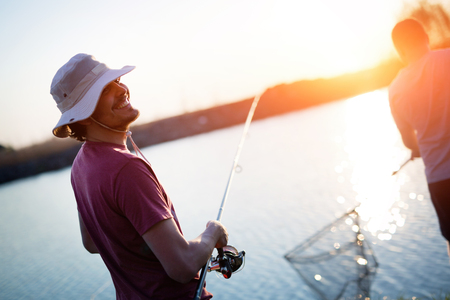Choosing the Right Fishing Clothing Material
When it comes to caring for your fishing clothing and ensuring it lasts season after season, everything starts with selecting the right material. In the U.S., anglers are spoiled for choice, but not all fabrics are created equal. Technical fabrics like polyester blends, nylon, or modern synthetics offer significant advantages over traditional materials such as cotton. These advanced textiles are designed to wick moisture away from your skin, dry quickly, and provide UV protection—key features when youre spending long hours under the sun or battling unpredictable weather out on the water.
By contrast, traditional materials like cotton may feel comfortable at first but tend to hold onto moisture, leading to discomfort and even chafing during extended trips. Cotton also takes much longer to dry if you get splashed by a rogue wave or caught in a rain shower. Choosing technical fabrics means youll benefit from increased durability, reduced odor retention, and a lighter load when packing for multi-day fishing adventures.
Your choice of material directly impacts not just how long your gear will last, but also how comfortable you feel during those marathon days chasing fish. With the right fabrics, youll spend less time worrying about soggy clothes and more time focusing on the next big catch.
Proper Washing and Drying Techniques
To keep your fishing clothing performing at its best season after season, it’s essential to wash and dry it with care. Many anglers overlook this step, but following a few simple guidelines can make a big difference in the long-term durability of your gear. Here’s how you can clean your fishing clothing without compromising its special features or comfort.
Recommended Detergents
Choose detergents that are free from harsh chemicals, fragrances, and fabric softeners. These additives can break down waterproof coatings and breathable membranes over time. Opt for mild or specialized sportswear detergents designed for technical fabrics.
| Detergent Type | Best For | Avoid |
|---|---|---|
| Mild Liquid Detergent | General fishing apparel | Heavy-duty cleaners, bleach |
| Sportswear Detergent | High-performance, moisture-wicking fabrics | Fabric softeners |
| Specialized Outdoor Washes | Waterproof/breathable clothing (e.g., Gore-Tex) | Scented detergents |
Machine Settings Matter
Always check the care label before tossing your gear into the washer. In general, use cold water and a gentle cycle to preserve technical fibers and prevent shrinking. Zip up all zippers, fasten Velcro tabs, and turn garments inside out to protect outer surfaces.
| Setting | Description | Purpose |
|---|---|---|
| Cold Water Wash | Keeps colors bright; reduces shrinkage | Preserves fabric integrity |
| Gentle Cycle | Less agitation on delicate gear | Prevents wear and tear on seams/zippers |
| No Fabric Softener | Avoids clogging performance fibers/membranes | Keeps breathability intact |
The Right Way to Air Dry Fishing Clothing
Avoid using high heat from dryers, as this can damage synthetic fibers or waterproof coatings. Instead, hang items in a shaded, well-ventilated area out of direct sunlight. This prevents color fading and maintains the flexibility of elastic bands or waterproof treatments.
- Hang Up: Use hangers for shirts/jackets; lay flat for heavier items like bibs.
- No Sunbathing: Direct sunlight may cause fading or degrade materials.
- Avoid Dryer Sheets: They leave residues that reduce breathability and water resistance.
- Pocket Check: Always empty pockets before washing to avoid accidental damage.
Treating your fishing clothes with care ensures they’ll be ready for every sunrise trip and lakeside adventure—keeping you comfortable and protected no matter what the day brings.
![]()
3. Dealing with Stains, Odors, and Fish Residue
Fishing clothing is bound to get messy—whether it’s from bait splatters, fish slime, or just the general grime of a good day out on the water. The key to long-lasting gear is knowing how to tackle these stubborn stains and lingering odors right at home. Start by shaking off any loose debris or rinsing off mud as soon as possible to prevent stains from setting. For spot cleaning, mix a bit of mild dish soap with warm water and gently scrub the affected area using a soft brush or an old toothbrush—this works wonders on blood or bait stains. If you’re dealing with tough fish smells, try soaking your clothes in a mixture of white vinegar and cold water for about 30 minutes before washing; vinegar naturally neutralizes odors without harming technical fabrics.
For persistent grime or greasy residues, sprinkle baking soda directly onto damp spots and let it sit for 15-20 minutes before tossing the garment in the wash. Baking soda not only lifts stains but also helps keep your fishing clothes smelling fresh. If you prefer ready-made solutions, many outdoor retailers sell specialty detergents designed for performance wear that target odors and organic stains without stripping away water-resistant finishes.
Always check care labels for specific instructions—some materials, like Gore-Tex or DWR-coated fabrics, require gentle handling and should avoid harsh chemicals. When in doubt, opt for air drying your gear outdoors rather than using a dryer; sunlight acts as a natural deodorizer and helps keep fabrics in top shape for future adventures.
4. Storing Your Fishing Clothes Safely
Proper storage is a game-changer when it comes to extending the life of your fishing clothing. Whether you stash your gear in the garage, toss it in the back of your truck, or hang it up in a dedicated closet, how you store your clothes can make all the difference. Mildew, fading, and general wear are common enemies that sneak up when gear is left damp, crumpled, or exposed to sunlight for too long. Here’s how to keep your fishing apparel fresh and ready for your next adventure:
Keep It Clean and Dry
Never store fishing clothes while they’re still wet or dirty. Moisture leads to mildew and stubborn odors that are tough to get rid of. Give everything a thorough wash and let each piece air dry completely before putting them away.
Choose the Right Storage Spot
The location matters more than you might think. Direct sunlight can fade colors, while cramped, humid spaces invite mold and mildew. Consider these options:
| Storage Location | Pros | Cons |
|---|---|---|
| Garage | Easy access, plenty of space | Can be humid or dusty; avoid direct sunlight |
| Truck Bed/Back Seat | Convenient for quick trips | Exposed to temperature swings; risk of UV damage if not covered |
| Dedicated Gear Closet | Controlled environment; best for long-term storage | Takes up indoor space; need good ventilation |
Smart Storage Solutions
If you’re storing gear for more than a few days between trips, use breathable garment bags or mesh storage bins. Avoid airtight plastic containers unless you’re absolutely sure the clothes are bone dry—otherwise, you’ll trap moisture and create a breeding ground for mildew.
Extra Tips for American Anglers:
- Add cedar blocks or silica gel packs to absorb moisture and keep things smelling fresh.
- If you fish saltwater, double-check that every item is fully rinsed and dried before storing—salt residue can attract moisture and degrade fabrics over time.
- Label bins by season or trip type (summer bass gear, cold-weather trout layers) so you can grab what you need fast.
Quick Recap: Do’s & Don’ts for Storing Fishing Clothes
- Do: Wash and dry completely before storing.
- Do: Use breathable storage solutions.
- Don’t: Store in direct sunlight or humid areas.
- Don’t: Cram clothes tightly together—give them room to breathe!
Sensible storage habits not only keep your fishing clothes looking sharp but also save you money by reducing the need for replacements. A little extra care between trips means your go-to shirts, pants, and rain jackets will always be ready for action when the bite is on.
5. Repairing Damage and Extending Life
Even with the best care, your fishing clothes are bound to face a little wear and tear after countless adventures on the water. Instead of tossing out your favorite shirt or waders at the first sign of trouble, try these practical tips to keep them in action for many more seasons.
Patch Up Minor Rips and Tears
Small rips and snags are almost inevitable, especially when you’re pushing through brush or scrambling over rocks. For quick fixes, fabric repair tape is a game changer—just clean the area, stick it on both sides if possible, and press firmly. For larger tears, sewing with a strong nylon thread can provide a durable solution. Always keep a compact sewing kit or patch kit in your gear bag for those unexpected mishaps.
Troubleshooting Zipper Issues
Zippers can get stuck with sand, salt, or just plain old dirt. If your zipper starts sticking, gently run a graphite pencil or a zipper lubricant along the teeth to smooth things out. For broken zipper pulls, use a sturdy key ring or zip tie as a temporary fix until you can replace it properly.
Protecting Against Sun Damage
Sunlight is tough on fabrics, causing fading and weakening over time. To extend the life of your shirts and hats, rotate them regularly so no single item gets all the sun exposure. Consider using UV-protective sprays designed for outdoor apparel to boost their resistance to rays. When you’re off the water, hang up your gear in a cool, shaded spot rather than leaving it in direct sunlight or inside your hot car.
By tackling small repairs as soon as they pop up and taking simple steps to prevent further damage, you’ll keep your favorite fishing clothes ready for every cast, hike, and campfire story—season after season.
6. When it’s Time to Retire and Replace
No matter how well you care for your fishing clothing, every piece eventually reaches the end of its journey. Recognizing when your favorite gear has outlived its usefulness is just as important as maintaining it. Watch for obvious signs like thinning fabric, persistent odors that won’t wash out, broken zippers, or seams that no longer hold up. If your rain jacket is no longer waterproof or your sun shirt isn’t blocking rays like it used to, those are clear indicators it’s time for an upgrade.
Don’t Compromise on Safety
Fishing clothing does more than look good—it protects you from the elements. Worn-out waders with leaks can lead to uncomfortable and even dangerous situations in cold water. Faded hats or gloves may not provide adequate sun protection anymore. If you notice any safety concerns, don’t wait; replacing your gear is an investment in your health and comfort on the water.
Comfort and Performance Matter
Comfort is key during long days outdoors. Clothing that chafes, sags, or doesn’t fit right due to wear can turn a great day of fishing into a miserable experience. High-quality performance materials lose their effectiveness over time, so if you’re not staying dry, cool, or warm as you should, consider making the switch.
Upgrade Wisely
When you’re ready to retire old pieces, look for new gear that fits your fishing style and local climate. Advances in materials mean today’s fishing clothing is more comfortable and durable than ever before. By knowing when to say goodbye and invest in new essentials, you’ll keep each trip safe, enjoyable, and memorable—just as it should be.


